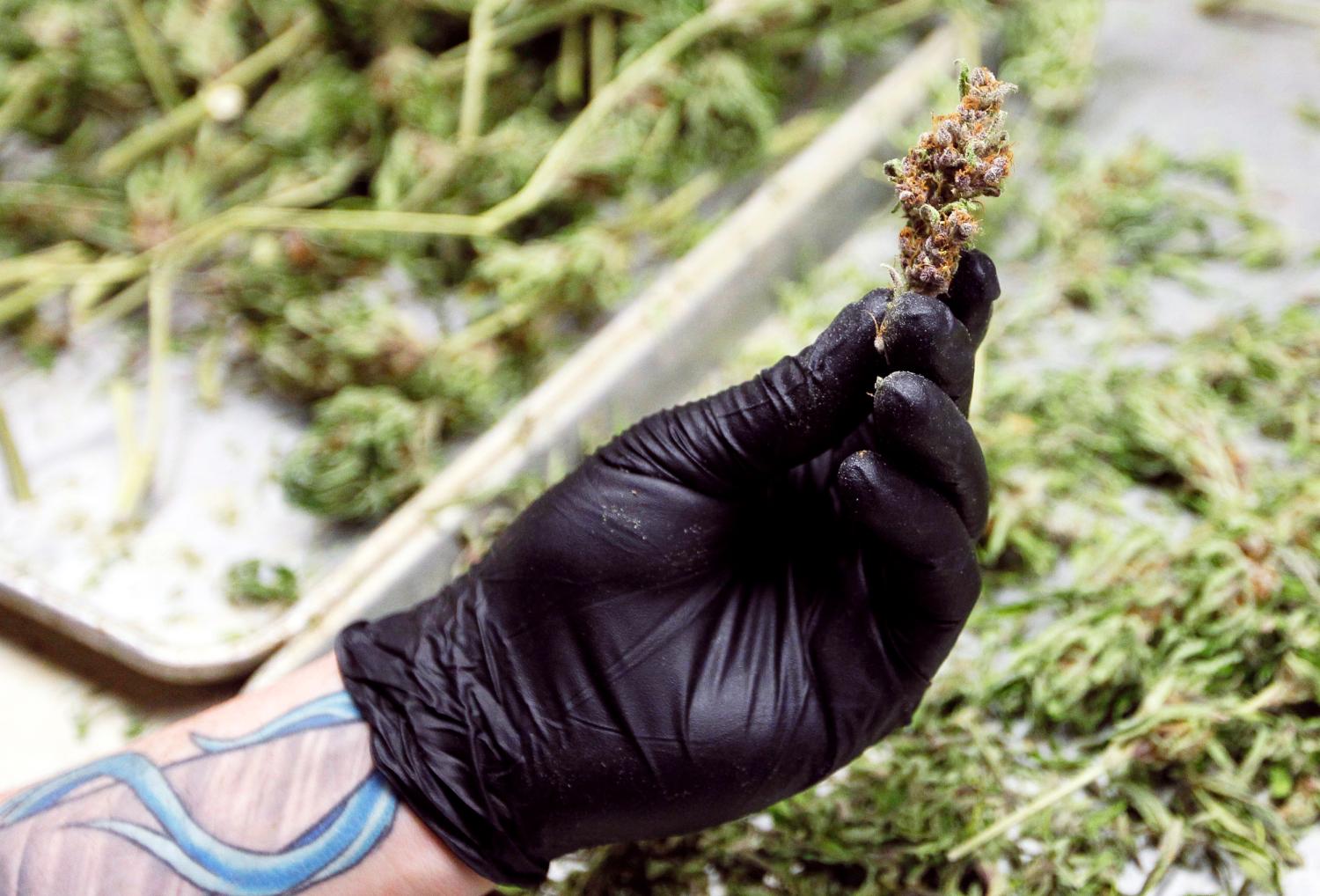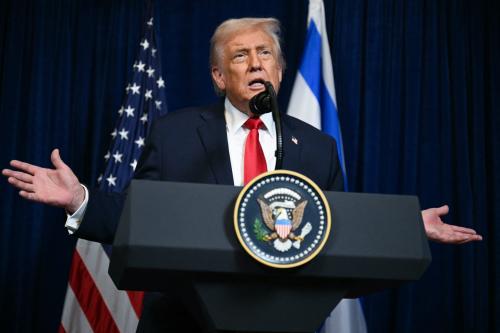Editor’s Note: As a part of our work on the legalization of marijuana, this paper is published in partnership by Governance Studies at Brookings and the Washington Office on Latin America (WOLA). It is edited by John Walsh, with contributions from Mark Kleiman [i] and BOTEC Analysis [ii].
Last November, Colorado and Washington voters approved ballot initiatives to legalize, regulate and tax marijuana—decisions that put them at odds with federal law, which continues to ban marijuana. The states are moving ahead with implementation of their unprecedented laws in the face of uncertainty regarding the response of the federal government. What exactly have the states voted to do? Given current federal law, how might the Obama administration respond? What are the trends in U.S. public opinion on marijuana policy?
1. What are the key features of the initiatives that Colorado and Washington Voters approved?
Both states legalized marijuana possession for personal use by adults ages 21 and older. Colorado, but not Washington, also legalized production for personal use (though Washington residents with medical recommendations may also grow their own marijuana). Both states will create systems of legal production and sale, subject to licensing, regulation and taxation. For those younger than 21, all aspects of marijuana use, possession and sale will remain illegal.
2. What are the major similarities and differences between the Colorado and Washington laws to legalize and regulate marijuana?
Washington and Colorado took identical approaches to possession and age limits: adults 21 and older can possess up to one ounce at any time, normally a misdemeanor charge. The states also appear likely to adopt the same DUI policy, restricting driving with blood THC concentrations higher than 5 nanograms per milliliter (ng/mL). The Colorado laws are more liberal in that they allow unlicensed production for personal use (up to three maturing plants at a time) and non-commercial transactions up to one ounce.
The states’ laws share similar taxation structures, with modestly heavier taxes in Washington. Washington levies between two and three 25 percent excise taxes within the supply chain, depending on industry structure, yielding a total tax burden likely somewhere between 30 and 40 percent, plus sales tax. Colorado has enacted a 15 percent excise tax on unprocessed product and a 10 percent sales tax, for an approximate effective tax rate between 15 and 25 percent. The precise effective tax rates will vary based on the price of unprocessed marijuana relative to the total retail price, and with varying local sales taxes.
The laws impose different industry structures and build on their existing medical systems in different ways. In Washington, vertical integration across production and sale (i.e., a single entity producing and selling) is forbidden, and thus far no special allowances to current medical marijuana operators have been announced. In Colorado, the new legal structure is more consistent with its existing, vertically integrated medical market. Vertical integration will be required for commercial marijuana industries in Colorado until October 2014, when stand-alone producers and retailers will be allowed. Pre-existing medical marijuana operators in Colorado will also be given exclusive rights to licenses for the first three months.
3. What is the timetable for implementing the new laws?
Washington’s Initiative 502 requires rules to be in place by December 1, 2013. The current timeline calls for the state’s Liquor Control Board to publish draft regulations in mid-June, begin to accept and review license applications in August, and begin to issue licenses by December 1.
Colorado’s Amendment 64 requires the state’s Department of Revenue to adopt all necessary regulations by July 1, 2013, and to begin accepting and processing license applications on October 1, 2013. Current plans call for commercial retail sales by early 2014.
4. Who is responsible for overseeing implementation?
The commercial market in Washington State is to be supervised by the Washington State Liquor Control Board. No state agency regulates production and distribution under the state’s medical marijuana law; there are proposals for giving the Liquor Control Board such authority.
Colorado’s law vests authority to regulate the commercial market in the newly created Marijuana Enforcement Division of the Department of Revenue; the Medical Marijuana Enforcement Division was already regulating that part of the market.
5. What is federal law regarding the cultivation, distribution, possession and use of marijuana?
The Controlled Substances Act (CSA) of 1970 makes marijuana a Schedule I substance. Cultivation and distribution (which includes gift as well as sale) are felonies; possession for personal use is a misdemeanor. Use is not itself a crime, but there is no way to use marijuana without possessing it first, and possession of “paraphernalia” is also illegal. Cultivating marijuana 100 plants or more carries a mandatory minimum sentence of five years under federal law.
6. What has the Obama administration said about the new state laws?
The Administration has yet to announce a clear policy on the new laws. President Obama, in a December 2012 TV interview with Barbara Walters, acknowledged that the voters of Washington and Colorado had spoken on the issue, that it “does not make sense” for federal enforcement to prioritize recreational drug users in states where use is legal under state law, and that there is a need for “a conversation” about reconciling state and federal law. At the same time, he pointed out that the federal law remains in effect and that the executive branch has the responsibility to enforce the laws.
The Department of Justice (including the Drug Enforcement Administration) has made it clear that the provisions of the CSA covering marijuana remain in force, with Attorney General Eric Holder expressing particular concern about the potential effects of the new state laws on marijuana use by minors. The Director of the Office of National Drug Control Policy (ONDCP) has expressed continued opposition to marijuana legalization. Negotiations are reportedly taking place between federal officials and Colorado and Washington state officials.
During a March 2013 Senate Judiciary Committee oversight hearing, Attorney General Holder, in response to Senator Patrick Leahy’s questions about the new state laws, promised to announce a formal policy toward state marijuana legalization “relatively soon.”
7. What authority does the federal government have with respect to the new state laws?
The federal government maintains the power to enforce federal law; however, it cannot compel states to assist in enforcing that law, and the states have no obligation to forbid the same drugs that the federal government forbids. The practical capacity of the federal government to suppress marijuana production and sale without cooperation from the states and localities is open to question, since more than 95 percent of marijuana-law arrests are made by state and local police rather than federal drug enforcement agents.
However, the systems of licensed, regulated, and taxed production and sale created by the Washington and Colorado laws are more vulnerable to federal control than the purely illicit markets, simply because participants in the legal markets are required to identify themselves by applying for state licenses. Federal law enforcement authorities have a variety of criminal and civil tools to deploy against the relatively small number of entities that will ultimately receive licenses to produce or sell marijuana.
By contrast, federal officials lack the resources to identify or take action against the individuals who can now legally possess marijuana in both states, or against individuals who are authorized to grow (but not sell) small amounts of marijuana, either as authorized medical users in Washington or all adult residents of Colorado.
It would be very difficult for the federal government, without local help, to prevent production shielded by those provisions from entering illicit interstate commerce and reducing illegal marijuana prices in neighboring states, and eventually perhaps nationwide. Thus, perversely, the federal government is better able to prevent the operation of legal, regulated marijuana production and sales than it is to prevent the operation of purely illicit markets.
8. Under current federal law, what are options are available to the federal government in responding to the new state laws?
Given the constraints imposed by current federal law, the federal government could (1) sue to invalidate the state laws under the Supremacy Clause and to enjoin state authorities from issuing licenses to marijuana growers and sellers; (2) use injunctions, threats of asset forfeiture, or criminal prosecution to shut down state-licensed marijuana businesses; (3) unilaterally establish a set of enforcement priorities to de-emphasize attacks on state-legal businesses; or (4) enter into cooperative enforcement agreements with the states that could implicitly allow state-regulated systems to function, though without making them legal under federal law.
The CSA itself (21 U.S.C. §873) directs that the Attorney General “shall cooperate” with the state and local governments in enforcing the drug laws, and gives him the power “to enter into contractual agreements […] to provide for cooperative enforcement and regulatory activities.”
Federal accommodation of the new state laws would offer several potential advantages. It would increase the capacity of governments at all levels to shape the behavior of marijuana-industry participants; it might enable a joint enforcement focus on inter-state transactions; it would acknowledge the sovereign powers that the states share with the federal government; and it would enable the acquisition of more knowledge than is now available about the operations and consequences of legal, open marijuana markets. On the other hand, it would involve effective acquiescence by the executive branch in the open violation of unrepealed federal criminal laws, and its consistency with treaty obligations is questionable.
Shutting down regulated and taxed enterprises, whose operations could potentially be confined within the boundaries of a single state, might expand the scope of operation for unregulated and untaxed enterprises with far less reason to pay attention to state boundaries. Therefore it is an open question whether the goal of reducing drug abuse would be better served by accommodation or by a federal effort to shut down the Colorado and Washington systems.
9. What impact might the Colorado and Washington laws have on marijuana exports from other countries into the United States?
Since Colorado and Washington combined account for less than five percent of estimated total U.S. marijuana sales, legalization in those states is not likely to significantly cut the revenues of foreign drug suppliers (and in particular Mexican drug trafficking organizations) unless marijuana produced in Washington or Colorado can be distributed across state boundaries at prices competitive with Mexican imports. The price of exported marijuana from Washington or Colorado will depend on several factors, including (a) the price of production in state-legal markets, (b) the extent to which product diversion occurs before the imposition of taxes, and (c) the effectiveness of federal, state, and local enforcement efforts to prevent diversion and interstate trafficking. Finally, the ability of Washington- or Colorado-produced exports to compete with imports hinges on how many grams of lower-potency Mexican marijuana consumers will see as being equivalent to one gram of higher-potency, Washington- and Colorado-grown marijuana (i.e., how closely users view the two forms of the drug as substitutes).
Even in the extreme case that production in Colorado and Washington were to entirely displace Mexican marijuana from the U.S. market, Mexican drug trafficking organizations (DTOs) would see reduced profits but would not be crippled. They currently earn between a fifth and a third of their drug export revenues from marijuana; those figures do not include their earnings from sales for domestic Mexican consumption or their non-drug revenues from kidnapping and extortion. However, the potential effects of marijuana legalization on Mexican DTOs’ sales of other drugs in the United States are unknown. To the extent that marijuana sales help maintain an illicit infrastructure that facilitates smuggling and distributing a range of illegal commodities, reducing the marijuana market could have helpful spillover effects for reducing the markets for cocaine, heroin, and methamphetamine.
10.
What are the trends in U.S. public opinion on the question of marijuana legalization?
Since the early 1990s, U.S. public opinion has trended in favor of marijuana legalization. Currently, a majority of Americans support legalization by a margin of seven points—52 percent to 45 percent, according to findings from a Pew Research Center survey in March 2013. Support for marijuana legalization has risen sharply since 2010, by 11 percentage points.
Part of the trend involves the replacement of (largely anti-marijuana) pre-Boomer-generation voters with more marijuana-friendly Gen-X members and Millenials. But the trend towards favoring marijuana legalization extends across all age groups. The most striking change has occurred within the Baby Boomer generation, comprising Americans born between 1946 and 1964. Whereas only 24 percent of Baby Boomers approved of legalization in 1994, 50 percent now count themselves in favor of it. In the last decade, support has nearly doubled among the Silent Generation—those Americans born between 1925 and 1942—from 17 percent in 2002 to 32 percent in 2013. Members of so-called “Generation X”—Americans born between 1965 and 1980—have also trended in support of legalization, growing from 28 percent in 1994 to 54 percent in 2013. Among Millennials—those born after 1980—support has risen from 36 percent in 2008 to 65 percent in 2013.
11. Does the public favor federal accommodation of the new state laws or intervention to block the new laws from being implemented?
The prospect of federal intervention to override the new state laws appears to be widely unpopular. A USA Today/Gallup poll conducted after the November 2012 elections found that 63 percent of Americans opposed federal intervention in states that legalized marijuana.
Reflecting changing opinions regarding marijuana legalization, Pew’s March 2013 survey found that 72 percent of Americans believe that government efforts to enforce current marijuana laws cost more than they are worth. Consistent with the USA Today/Gallup poll, Pew also found that 60 percent of Americans oppose federal enforcement in states that have chosen to legalize, including 64 percent of Independents, 59 percent of Democrats, and 57 percent of Republicans.
12. Are other states considering legislation or ballot measures that would legalize marijuana?
Reportedly there may be initiatives for full commercial legalization on the ballot in Alaska in 2014 and in California, Maine, and Oregon in 2016. (Presidential years bring out an electorate more favorable to marijuana legalization than the off-year electorate.) The shape and fate of those propositions depends in part on outcomes in Colorado and Washington, including how the federal government responds.
[i]Mark Kleiman is Professor of Public Policy at UCLA, and Visiting Fellow at the National Institute of Justice.
[ii]BOTEC Analysis is a networked organization that applies the techniques of public policy analysis to the problems of drug abuse and crime control. BOTEC contributors include: Steven Davenport, Daniel Fisher, Tom Jacobson, and Jeremy Ziskind.
The Brookings Institution is committed to quality, independence, and impact.
We are supported by a diverse array of funders. In line with our values and policies, each Brookings publication represents the sole views of its author(s).




